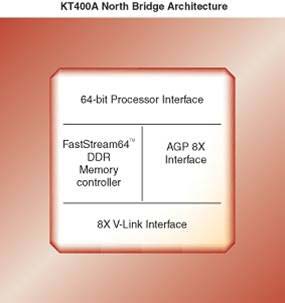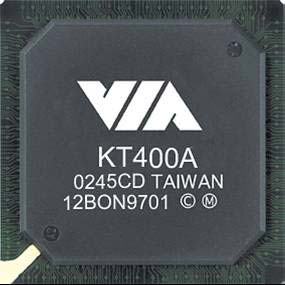VIA Responds with KT400A, Five Months Later
by Anand Lal Shimpi on March 10, 2003 12:19 PM EST- Posted in
- CPUs
KT400A North Bridge
In their very motherboard-manufacturer friendly nature, VIA has once again made the 'A' update to their latest chipset pin-compatible with its predecessor; the KT400A North Bridge is a drop in replacement for the KT400, which isn't really a surprise considering that the basic feature set of the North Bridge remains unchanged.

The KT400A still boasts support for AGP 8X, 266/333MHz FSB, DDR200/266/333/400 and features a 533MB/s link between the North and South Bridge. You'll realize that this feature list is virtually unchanged from the KT400, which makes sense considering the only changes to the North Bridge are confined to the memory controller itself.
Putting the marketing machine to work, VIA coined a new term this time to describe the improvements they made to the memory controller. If NVIDIA can brand dual channel DDR as DualDDR then VIA saw no harm in explaining the high-performance of their single channel memory controller with the term FastStream64 Technology.
There's nothing terribly unique about FastStream64 compared to previous North Bridge improvements VIA has made, the difference this time around is that they are giving the improvements a marketing name - not a bad idea, considering the competition they're up against. The improvements to the memory controller mainly come in the form of deeper buffers, which in turn allow data to stream in a more uninterrupted fashion from main memory to the CPU.

Remember that all memory requests must pass through the North Bridge, and every single bit of data that the CPU needs from main memory must be sent through the North Bridge. The deeper the command and data buffers in the North Bridge, the more requests can be actually stored in the North Bridge and quickly fed to the CPU, instead of causing cycle eating delays in the CPU's pipeline. The most extreme example of this is a situation where the CPU is waiting for a piece of data from main memory before completing an add instruction, if that data can't be pulled into the North Bridge because all of its data buffers are full the CPU not only has to wait the usual time for the data to come from main memory, but it must now wait longer because it must wait for the North Bridge to finally evict data from its buffer before the CPU can continue on. This obviously increases overall memory access latency because it now takes even longer to get data from main memory, which we already know is incredibly slow.
Along with deeper command and data buffers, VIA also outfitted the KT400A with deeper prefetch buffers that allow even more data to be pre-fetched from main memory into the North Bridge without specifically being requested by the CPU. The way prefetching works depends on a lot of the same principles as a CPU's cache, and the idea is that if the North Bridge prefetches correctly (it correctly guesses what data will be needed by the CPU in the very near future), data will only have to travel half as far to get to the CPU as it will be pulled from the North Bridge's prefetch buffers instead of from main memory.
More prefetch buffers means more room to store prefetched data, it is the equivalent of moving to a larger cache on a CPU; hit rate (and thus performance) inevitably improves because there's more data in the cache, or in this case, in the buffer. We're not sure if VIA actually improved the algorithms in which they use to prefetch data into the North Bridge, and given the tight lipped nature of these companies and their IP (understandably so) it is virtually impossible to make a quantified comparison between the prefetch unit of NVIDIA's nForce2 and that in VIA's KT400A.
Just like the nForce2, the KT400A will run faster with the memory and FSB frequencies in sync with each other (e.g. 333MHz FSB and DDR333, instead of 333MHz FSB and DDR400).










0 Comments
View All Comments